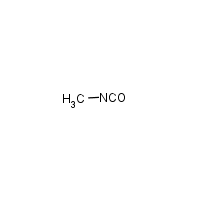Methyl isocyanate
Agent Name
Methyl isocyanate
CAS Number
624-83-9
Formula
C2-H3-N-O
Major Category
Toxic Gases & Vapors

Synonyms
Iso-cyanatomethane; Isocyanate de methyle [French]; Isocyanate, methyl-; Isocyanic acid, methyl ester; Methane, isocyanato-; Methyl carbonimide; Methyl isocyanat [German]; Methyl isocyanat [German]; Methyl isocyanate; Methyl isocyanide; Methylcarbylamine; Methylisocyanaat [Dutch]; Methylisokyanat [Czech]; Metil isocianato [Italian]; TL 1450; [ChemIDplus] UN2480
Category
Monoisocyanates
Description
Colorless liquid with a sharp, pungent odor; [NIOSH]
Sources/Uses
Used in the production of insecticides, herbicides, polyurethanes, and other plastics; [ACGIH] Released from a pesticide factory in Bhopal India in 1984, killing about 2.500 people and leaving many survivors with chronic lung disease; [Rom, p. 503-4]
Comments
Methyl isocyanate can cause eye and skin injuries, pulmonary edema, and possibly immunological asthma. Skin sensitivity to methyl isocyanate developed in all sixteen guinea pigs tested. [ACGIH] Causes second and third degree burns after short skin exposures; [CHRIS] In high-dose reproductive studies of animals, methyl isocyanate decreases fertility and increases fetal losses and birth defects. Women exposed in the Bhopal disaster had higher rates of spontaneous abortions than controls. [Frazier, p. 344-5] A lachrymator; [HSDB] Methyl isocyanate is fibrogenic to the lungs in the context of an acute inhalation exposure complicated by bronchiolitis obliterans.
Reference Link #1
Biomedical References
Exposure Assessment
Skin Designation (ACGIH)
Yes
TIH
Yes
TLV (ACGIH)
0.02 ppm
STEL (ACGIH)
0.06 ppm
PEL (OSHA)
0.02 ppm
MAK
0.01 ppm
IDLH (NIOSH)
0.12 ppm
Excerpts from Documentation for IDLHs
Lacrimation and irritation of the eyes, mucous membranes and skin; "Human data: Volunteers experienced eye irritation and lacrimation after 1 to 5 minutes at 2 ppm, with more marked irritation at 4 ppm; exposures were unbearable at 21 ppm [Kimmerle and Eben 1964]. In another study, volunteers noted eye irritation and lacrimation at 5 ppm in less than 50 seconds [Mellon 1963].
Vapor Pressure
348 mm Hg
Odor Threshold Low
2.1 ppm
Lethal Concentration
LC50 (rat) = 6.1 ppm/6 hr
Explanatory Notes
Odor threshold from AIHA; Flash point = -7 deg C; VP from HSDB;
Reference Link #2
NFPA
may ignite at ambient temp
ERPG-1
0.025 ppm
ERPG-2
0.25 ppm
ERPG-3
1.5 ppm
Adverse Effects
Skin Sensitizer
Yes
Asthma
Yes
Lachrymator
Yes
Toxic Pneumonitis
Yes
Fibrogenic
Yes
Reproductive Toxin
Yes
Dermatotoxin
Skin burns
Diseases, Processes, and Activities Linked to This Agent
Diseases
Occupational diseases associated with exposure to this agent: